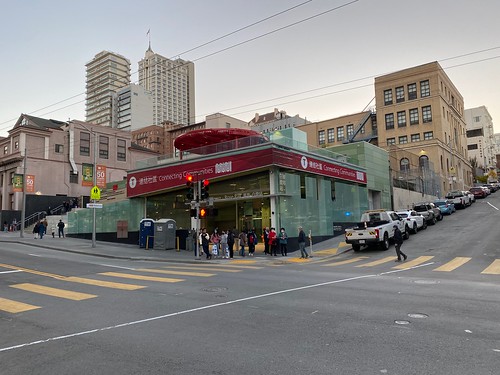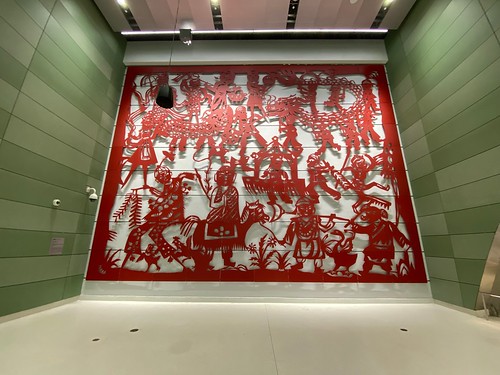When I first moved to San Francisco there was a new surface-level light rail line under construction along the east side of the city: the T Third Street line. This would be the largest expansion on the Muni Metro transit network since it opened, serving a part of the city that was both underserved by transit and filled with former industrial areas ripe for future development.
But the best part? This was only phase one of the plan. Phase two of what was then branded the “Central T Subway” was the city’s first new subway line in ages, connecting the new T Third line directly to downtown and Chinatown.
The first phase of the line opened in 2007, and after several delays the subway portion opened for free weekend preview service this month — some 15 years later.
Technically phase two involves four stations but one of them is above ground (yawn) so I’m only going to focus on the underground stations. We’ll go from south to north.
Yerba Buena/Moscone
Located about a block away from the entrances to the city’s Moscone Center buildings, this stop is aimed at catering to the convention goers in town. It’s not a particularly fancy station but it’s filled with giant rooms with large pieces of art.
Notably the building features large format prints of photos taken by a local student during the construction of the first part of Moscone Center back in the early 1980’s.
I’m not sure how many people would stop at this station to visit Yerba Buena Gardens, but it’s also close to SFMOMA and the Contemporary Jewish Museum.
Union Square/Market Street Station
This station is almost entirely located under Stockton Street, with the exception of a small entrance on the southeast corner of Union Square. The concourse level also directly connects to the concourse level at the existing Powell Street Station.
This station had to be built with limited space above ground and had to be deep enough to go underneath the existing subway under Market Street. Despite the public art in the station it still feels a little utilitarian.
Makes you wonder what it would take to add some leaded blast doors and turn this into a nuclear fallout shelter if it comes to that.
Chinatown – Rose Pak Station
The new station with the largest above ground footprint is right in the middle of Chinatown. It will eventually have a public plaza on the roof although that wasn’t open the two times I visited.
The upper floors have a deep red and light emerald green color scheme that practically screams “Chinatown.” Unfortunately this design doesn’t fully make its way down to the platform level where it would be a good visual indicator for tourists and casual riders.
Since this station is the last stop on the line, trains can pull in and out on either side of the platform. There’s also a position to position extra trains in the tunnel to the north of the station.
The Central Subway’s most obvious problems
Any critic of this project will stress that this subway cost about one billion dollars per mile to build. That’s a fair criticism, although the biggest contributor to the cost wasn’t boring the tunnels but rather unforeseen consequences of the design choices, such as building subway stations deep underground.
The depth of the stations also presents some serious water leak issues. Yes, I was there on the opening weekend when Muni staff had tried to divert water seeping into Union Square Station using red plastic Solo cups. I’ll admit I didn’t believe what I was seeing at first; look, college was a long time ago and I probably haven’t seen one of those red Solo cups since then. I’d be a lot more worried about this if it were to ever flood again in San Francisco.
In my above description of the stations you might have noticed I only ever mentioned a single track switch. There’s one lonely crossover (or “scissor”) switch in the entire subway for trains to switch direction. That also means there’s a single point of failure, just like Muni Metro’s original subway where trains were regularly delayed due to a similar design at the pre-1990’s version of Embarcadero Station.
What could be easily improved
The station names commit what I consider to be a cardinal sin in place names: they’re too long. In my mind any type of transit stop — subway, airport, etc. — should be named and only named for the area it serves. That’s why I’d drop Rose Pak’s name from Chinatown Station. It doesn’t aid in navigation to have her name attached to the station. Likewise, Yerba Buena/Moscone should be shortened to simply “Moscone” as Yerba Buena Gardens is a relatively modest affair in comparison to the convention center. It also doesn’t help that the station is nowhere near Yerba Buena Island.
Union Square/Market Street Station is also way too long, but why does it need a name at all? Typically when a subway or train station adds a new platform, it’s absorbed into the existing station. Union Square/Market Street is clearly an extension of Powell Street Station — so why add to the confusion with a different name?
What needs to happen
Almost everyone agrees that it was a mistake to end the Central Subway in Chinatown. And you know what? The tunnel itself already extends to Washington Square in North Beach where the two boring machines were extracted at the site of the former Pagoda Palace movie theater.
Now obviously it would be disruptive to dig out a station, but since the tunnel already ends right in the middle of North Beach it seems hard to justify not building a station there.
The good news is there’s already plans in the works to build this as well as an extension to Fisherman’s Wharf. It’s still in the early stages but at least it’s a step in the right direction. Unfortunately though with projects like these the longer you wait to build them, the more they will inevitably cost.
One more thing
A few years ago I wrote about how the Central Subway’s control screen became briefly visible on the web. While that particular page was quickly reverted, it’s back and better than ever — but not at the same location.
Through some extremely advanced hacking (looking at the URL of a web browser displayed on a screen in one of the stations) I happened to come across this page which includes real-time snapshots of both subways.
The Central Subway is open for weekend preview service until January, when it will require paid fare and will run the full length between Sunnydale and Chinatown.
There is currently no cellular service in the Central Subway but the city’s free public wifi is available.








